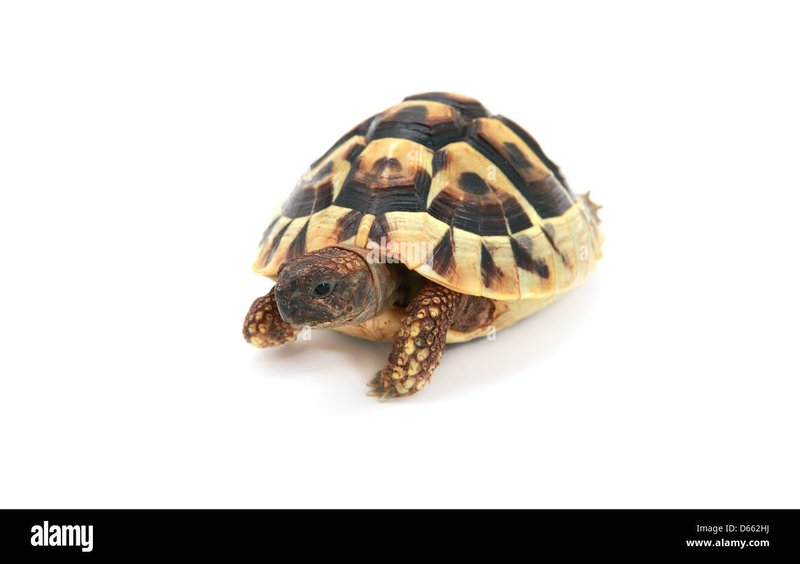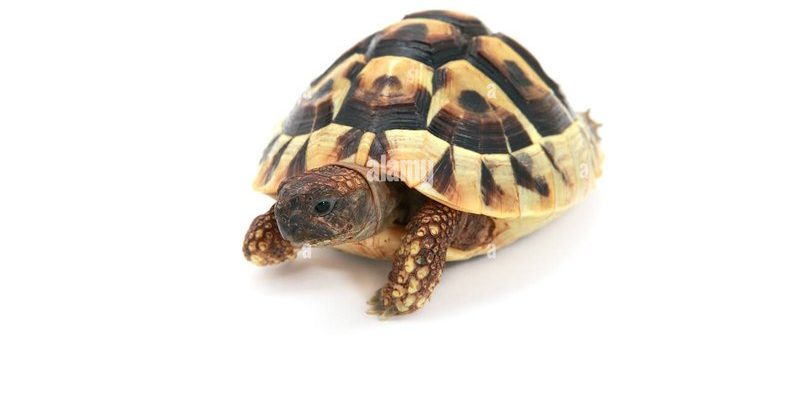
Physical Characteristics of Hermann’s Tortoise
Identifying a Hermann’s tortoise starts with their physical features, which are quite distinctive. First off, these tortoises have a dome-shaped shell that’s usually yellowish or brown with black markings. If you look closely, you’ll notice that the patterns can vary a lot; no two shells are exactly the same. This unique coloration helps them blend into their natural habitat, which is primarily dry and rocky environments in Europe.
Another telling feature is the size. Adult Hermann’s tortoises typically grow to be about 5 to 10 inches long. Their compact size makes them perfect for a garden or a small backyard, but don’t be fooled—they still need plenty of space to roam and explore. The unique shape of their shell also makes them a bit different from other species; they often have a more flattened look compared to their cousins.
Let’s not forget their limbs! Hermann’s tortoises have sturdy, column-like legs that help them move around on rocky terrain. Their feet are not webbed, which is another clue that distinguishes them from aquatic turtles. Instead, they have padded toes that allow them to grip surfaces well. So, if you spot a tortoise and see these leg features, you might just be looking at a Hermann’s tortoise!
Behavioral Traits of Hermann’s Tortoise
Beyond their physical characteristics, Hermann’s tortoises have unique behavior patterns that make them stand out. If you spend enough time observing them, you’ll notice they are quite curious. They love to explore and will often dig around or burrow into the soil, especially if they’re feeling a bit shy or threatened. You might see them poking their heads out of their shells, taking in their surroundings with an inquisitive look.
Another key behavioral trait is their social nature. Hermann’s tortoises can be surprisingly friendly and enjoy interacting with humans—especially when food is involved! If you notice a tortoise eagerly approaching you during feeding time, it’s a good sign they’re comfortable and happy in their environment. Just remember, while they can be social, they also appreciate their alone time, so be sure to give them the space they need.
One thing to keep in mind is that Hermann’s tortoises hibernate during the winter months if kept outside in temperate climates. This hibernation instinct is crucial for their health, so if you’re looking at one that’s active in winter, it’s not likely a Hermann’s tortoise. Instead, consider the overall behavior and activity levels throughout the year to help you identify this species accurately.
Shell Patterns and Colors
The shell of a Hermann’s tortoise is one of the most defining features, and closely examining it can give you a lot of information about the tortoise’s identity. The top shell, known as the carapace, will often feature a rich blend of yellow, brown, and black. Each tortoise has its own set of markings, and usually, they will have a pattern that resembles a star or a variety of blotches.
You might be surprised to learn that the colors and patterns can be influenced by their environment and diet. For instance, tortoises that eat a lot of dark, leafy greens may have darker shells. This gives you another layer of detail to consider when trying to identify one. So, if you see a tortoise with a rather dark carapace, take a closer look—it could just be a Hermann’s!
Another important point to make is the differences in shell shape among tortoise species. Hermann’s tortoises typically have a more rounded shell compared to other species, such as the Indian Star tortoise, which has a more prominent star pattern. Watch for the overall curvature and shape, as this can also help differentiate between species.
Size and Age Indicators
Now, let’s talk about size and age because they’re vital clues in identifying a Hermann’s tortoise. As mentioned earlier, adults usually measure between 5 to 10 inches, but hatchlings will be significantly smaller, often around 2 inches. If you’re looking at a baby tortoise, it’s essential to be cautious. Young tortoises require a bit more care and a stable environment to thrive.
As they age, their shells will grow in size and may become rounder. A healthy Hermann’s tortoise should have a smooth shell without any cracks or deformities. If you notice a tortoise with a rough or uneven shell, it’s a red flag that something may be wrong with its health. Just remember, growth patterns can vary, so while size is an important factor, it’s not the only one to consider.
To give you a clearer picture, here’s a quick size guide:
| Age | Size |
|---|---|
| Hatchling | 2 inches |
| Juvenile | 3-5 inches |
| Adult | 5-10 inches |
This size guide will help you gauge whether you’re looking at a baby tortoise or a full-grown Hermann’s. Knowing this can make a big difference when it comes to choosing the right pet or understanding the tortoise’s needs as it grows.
Identifying Male vs. Female Hermann’s Tortoises
If you’re trying to figure out whether a Hermann’s tortoise is male or female, there are some easy differences to spot. Generally, male Hermann’s tortoises are smaller and have a concave shell shape, which helps them during mating. Females, on the other hand, are typically larger and have a flatter, more rounded shell. This design allows for egg-carrying.
Another tell-tale sign is the tail: male tortoises have longer and thicker tails compared to females, which have shorter and more slender tails. If you’re unsure, you can gently turn the tortoise upside-down to take a look—just be sure to support them properly, as they can be sensitive.
It’s interesting to note that these physical differences can develop over time, so if you’re looking at younger tortoises, it may be harder to tell them apart. Still, knowing these traits can help you identify their gender, which can be important for breeding or understanding their typical behavior.
Habitat and Location
Understanding the habitat and location of a Hermann’s tortoise can also play a crucial role in identification. These tortoises are native to parts of Europe, particularly in Mediterranean regions. They thrive in dry, warm, and rocky environments, often found in grasslands or scrublands where there’s an abundance of vegetation.
So, if you’re out in the wild and come across a tortoise, keep in mind that if it’s in a lush, wet area, it’s likely not a Hermann’s. They prefer areas where they can bask in the sun and enjoy the warmth without being too damp. These conditions help them stay healthy and active.
If you’re looking to adopt one, consider a habitat that mimics their natural environment. A sunny area with rocks to hide under and some greens to munch on will keep your Hermann’s tortoise happy and healthy. Providing the right habitat not only helps in identifying the tortoise but also ensures that you’re giving it the best care possible.
Being able to identify a Hermann’s tortoise is more than just an interesting skill; it’s crucial for ensuring their wellbeing. From understanding their needs to providing the right care, knowing how to recognize these charming creatures helps prevent misunderstandings and poor care practices. Whether you’re a potential owner or a curious nature-lover, identifying a Hermann’s tortoise enriches your experience and deepens your appreciation for these unique reptiles.
Ultimately, the world of tortoises is vibrant and diverse. So next time you spot a little shelled friend, you’ll be equipped with the knowledge to identify whether it’s a Hermann’s tortoise. Your journey into their world starts now—happy tortoise spotting!

